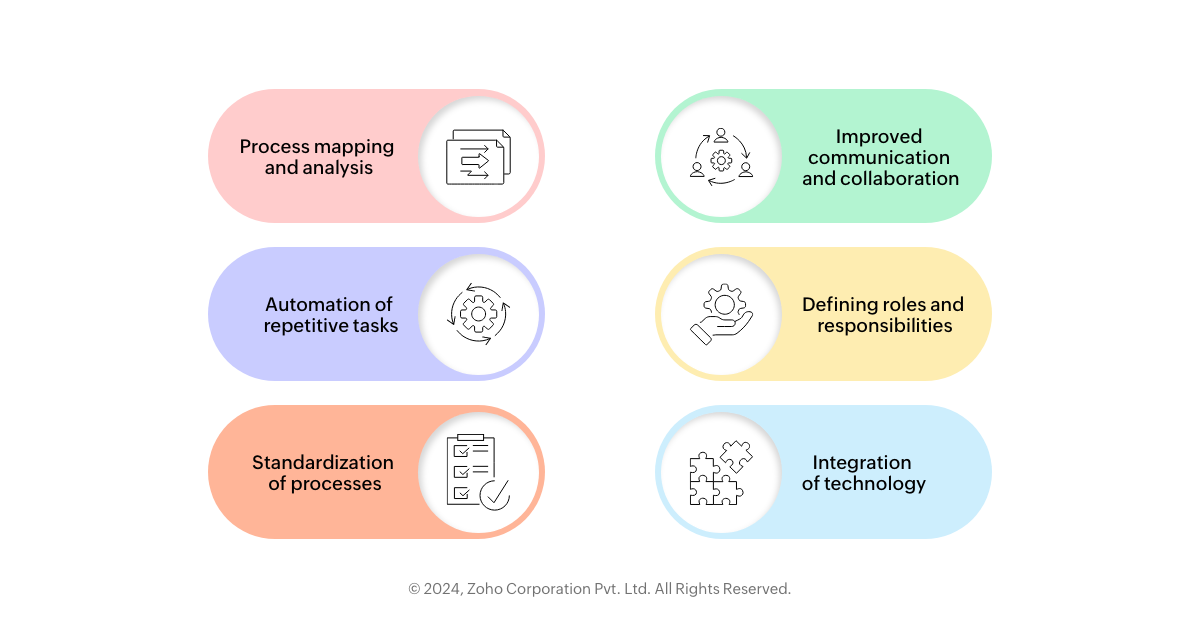- HOME
- Know Your Tech
- How important is business process for organizations?
How important is business process for organizations?
- Last Updated : October 24, 2024
- 430 Views
- 6 Min Read
Running a business involves a lot of moving parts, and it's easy for things to get a bit chaotic. That's where business process management (BPM) comes in. BPM is about getting your processes in order, making sure things run smoothly, and improving overall efficiency.
But, how is business process management important in organizations? This blog will look at common inefficiencies in organizations, explain how BPM tackles these issues, outline its connection to the customer experience, and lay out how it helps with automation and digitization.
Common inefficiencies in business processes
Every organization faces challenges. These are the little (or sometimes big) things that slow processes down and make work harder than it needs to be. Here are some of the most common hiccups.
Manual/Repetitive tasks
There are businesses that still handle tasks like data entry manually. This is not only time consuming, but also increases the chance of human errors. It's more like digging a hole with a spoon and not a shovel.
Lack of standardisation
Some tasks might have to be completed by different departments, and each with its own approach to it. This can lead to confusion and make it difficult to maintain consistency.
Unclear roles and responsibilities
If your employees don't know what they're responsible for, there's a high chance of duplicated work or, worse, major tasks being left undone.
Poor communication
When teams don’t communicate well, things can fall through the cracks. Let's say the sales team didn't brief the product team correctly about the client's requirements; then, you might end up with unhappy customers.
Outdated technology
Using outdated systems or software will slow things down and make it difficult for any kind of integration.
How BPM identifies and addresses these inefficiencies
So how does BPM address these challenges? Here are two real-world business use cases to explain things.
The first one is about WCube, a French design and web development company who faced issues due to their lack of standardization and reliance on outdated manual processes. As a growing company, they were handling project management tasks manually, resulting in delays and inconsistent work quality. To tackle these inefficiencies and streamline operations, WCube turned to Creator's BPM solution to develop a custom agile system that could adapt to their unique needs.
Another example is Adviso, a professional services firm offering strategic consulting, who encountered similar hurdles while managing their client service processes. Their operations lacked efficiency, and manual workflows made it difficult for them to scale. With increasing demands, Adviso sought out Creator's BPM solution to improve their workflow and client management processes, ultimately aiming to enhance operational efficiency and standardize their business processes.
Now, continuing with the examples, here's how BPM finds and fixes these inefficiencies.

Process mapping and analysis
The first step in BPM is mapping out all current processes. This is not just to create a flowchart, but also to get a deep understanding of how things actually work in practice. By business process mapping, you will be able to analyze where your tasks are getting stuck, duplicated, or where unnecessary steps are creeping in, contributing to continuous improvement.
For example, WCube’s existing manual project management system was causing delays and duplication of efforts. After implementing a custom BPM solution, they were able to map out their entire project workflow to identify bottlenecks and areas where automation could be introduced. This analysis helped them streamline the approval process and eliminate unnecessary steps. For WCube, what once took a week to approve now happens in a day, saving time and reducing frustration among employees.
Automation of repetitive tasks
Once you've identified where things are slowing down, the next step is business process automation. One of the big wins with BPM for organizations is that it lets you automate business processes that don’t need a human touch. Tasks like data entry or invoice processing are activities that are prone to human error when done manually. BPM systems can automate these tasks, ensuring they're done faster and with greater accuracy.
In the case of Adviso, they used business process management tools to automate repetitive administrative tasks, like scheduling and billing, which were prone to errors when handled manually. By automating these processes, they not only reduced human error but also freed up their team to focus on more critical tasks, such as client relationship management and strategy development. This move significantly improved their operational efficiency and gave them the bandwidth to focus on growing their business.
Standardisation of processes
In any organization, consistency is key. BPM helps standardize processes across the board, from trainees to managers. Whether it’s onboarding a new employee or processing a customer order, standardized workflows ensure every task is completed in the same way, every time. This consistency reduces the learning curve for new employees and minimizes the risk of errors. It also means that your customers or clients always receive the same level of service, which can significantly boost their trust and satisfaction.
Improved communication and collaboration
Staying transparent lets everyone in the organization stay on the same page and reduces the chance of something being missed. Since poor communication is often at the heart of inefficiencies, BPM tools include features designed to enhance communication and collaboration across teams. These tools even include centralized dashboards where everyone can track progress on various tasks and projects, leading to better business process monitoring.
For both WCube and Adviso, one of the most notable benefits of BPM was how it improved team collaboration. WCube’s custom BPM solution introduced dashboards that kept all team members updated on project progress, cutting down on miscommunication and missed deadlines.
Adviso, on the other hand, found that BPM helped them centralize their operations, allowing different departments to collaborate more effectively, especially when dealing with large client projects. This improvement in communication ensured teams were always on the same page, which directly impacted their overall performance and client satisfaction.
Defining roles and responsibilities
One of the common causes of inefficiency is the lack of clarity around roles and responsibilities. BPM helps by clearly defining who is responsible for what, using predefined workflows and role-based access controls to outline tasks and duties. This makes it easier to delegate tasks and hold people accountable. With clear roles, you can create specific to-do lists, ensuring nothing falls through the cracks, which ties into continuous business process improvement.
Integration of technology
Having systems that can talk to each other is essential, and BPM tools are capable of integrating with other systems like CRM and ERP software. This integration ensures data flows smoothly between systems, eliminating the need for manual data entry and reducing the risk of errors. BPM tools keep everything connected, which lets your business operate smoothly, unlike outdated systems that slow processes down.
BPM’s integration capabilities also came into play for WCube and Adviso. For WCube, their business process management system integrated with other business tools like Zoho CRM, which allowed data to flow seamlessly between departments. This reduced the need for manual data entry, which cut down on errors and delays. Adviso saw similar improvements by integrating their BPM system with their financial software, which streamlined their billing and reporting processes. In both cases, BPM allowed these companies to modernize their systems and create more cohesive workflows.
As a business grows, its processes often become more complex. Whether you're adding new products or expanding into new markets, BPM provides the flexibility to adapt to these changes. With automation and digitization becoming the major keys of success, business process management systems provide the tools and strategies needed to stay competitive and efficient. By continuously monitoring and improving your existing processes, BPM ensures your business remains agile.
Conclusion
BPM mainly focuses on enhancing the way your business operates. By identifying and fixing inefficiencies, BPM will help your organization save time and money, improve customer experiences, and stay competitive.
As seen in the cases of WCube and Adviso, implementing a custom BPM solution made a significant difference in their operations. BPM allowed them to tackle inefficiencies head-on, standardize their processes, and integrate modern technology into their workflows. Whether it’s managing projects or automating tasks, BPM helped them improve both their internal operations and the experience they offer to their customers. So, if you are someone looking to improve your business operations and complex business processes, implementing BPM is highly recommended.
Whether you are a small business or a large enterprise, BPM can make huge differences in how your organization runs and help you achieve your goals and stay aligned with them.
 Ann Elizabeth Sam
Ann Elizabeth SamHey! I'm Ann, and I work as a content writer at Zoho Creator. I'm exploring the SaaS world through various forms of content creation. Outside of work, I love dancing and would give up anything to read a good murder mystery.



